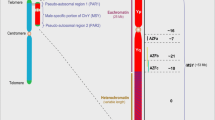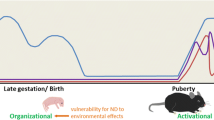Abstract
The identification of cancer susceptibility- and resistance-mediating genes is an essential prerequisite for prevention and early diagnosis of malignant tumors. Model organisms are helpful to identify variant alleles involved in pathways affecting individual cancer risk. BDIX and BDIV rats of both sexes are highly susceptible and resistant, respectively, to the development of N-ethyl-N-nitrosourea (ENU)-induced malignant peripheral nerve sheath tumors (MPNST), predominantly in the trigeminal nerves. Nevertheless, female (BDIV × BDIX) F2 intercross rats have a lower MPNST incidence and a longer latency time than males. Six of seven autosomal gene loci (Mss1-Mss7) controlling genetic susceptibility and resistance in (BDIV × BDIX) F2 hybrids exert allele- and sex-specific effects on tumor incidence and/or latency time of variable strength. Homozygous BDIV alleles at Mss4 or Mss7 located on rat chromosomes 6 and 10, respectively, are sufficient to cause almost complete resistance to ENU-induced MPNST development in female F2 rats regardless of the genotype of the other locus. Both loci display only weak effects on male cancer risk. Survival curves of ENU-treated F2 females depleted of animals with homozygous BDIV alleles at Mss4 and Mss7 are not significantly different from those of males, suggesting that these loci account mainly for the excess tumor resistance observed in female F2 rats. By haplotype analysis Mss4 and Mss7 could be narrowed down to 20 and 12 Mb, respectively, providing a basis for the positional identification of candidate genes.


Similar content being viewed by others
References
Aoyama H, Naito M, Fujimoto N, Oda M, Naito Y et al (1989) Effects of sex difference, gonadectomy and estradiol on N-ethyl-N-nitrosourea-induced trigeminal nerve tumors in rats. Carcinogenesis 10:1505–1509
Balmain A (2002) Cancer as a complex genetic trait: tumor susceptibility in humans and mouse models. Cell 108:145–152
Bond GL, Hirshfield KM, Kirchhoff T, Alexe G, Bond EE et al (2006) MDM2 SNP309 accelerates tumor formation in a gender-specific and hormone-dependent manner. Cancer Res 66:5104–5110
Cordell HJ (2002) Epistasis: what it means, what it doesn’t mean, and statistical methods to detect it in humans. Hum Mol Genet 11:2463–2468
De Miglio MR, Virdis P, Calvisi DF, Frau M, Muroni MR et al (2006) Mapping a sex hormone-sensitive gene determining female resistance to liver carcinogenesis in a congenic F344.BN-Hcs4 rat. Cancer Res 66:10384–10390
Dobyns WB, Filauro A, Tomson BN, Chan AS, Ho AW et al (2004) Inheritance of most X-linked traits is not dominant or recessive, just X-linked. Am J Med Genet A 129A:136–143
Druckrey H (1971) Genotypes and phenotypes of ten inbred strains of BD rats. Arzneimittelforschung 21:1274–1278
Druckrey H, Landschutz C, Ivankovic S (1970) Transplacental induction of malignant tumours of the nervous system. II. Ethyl-nitrosourea in 10 genetically defined strains of rats. Z Krebsforsch 73:371–386
Gering KM, Marx JA, Lennartz K, Fischer C, Rajewsky MF et al (2006) The interaction mode of premalignant Schwann and immune effector cells during chemically induced carcinogenesis in the rat peripheral nervous system is strongly influenced by genetic background. Cancer Res 66:4708–4714
Giangaspero F, Bigner SH, Kleihues P, Pietsch T, Trojanowsky JQ (2000) Medulloblastoma. In: Kleihues P, Cavenee WK (eds) Pathology and genetics of tumors of the nervous system. IARC Press, Lyon, pp 129–137
Kindler-Röhrborn A, Kolsch BU, Fischer C, Held S, Rajewsky MF (1999) Ethylnitrosourea-induced development of malignant schwannomas in the rat: two distinct loci on chromosome 10 involved in tumor susceptibility and oncogenesis. Cancer Res 59:1109–1114
Kindler-Röhrborn A, Kind AB, Koelsch BU, Fischer C, Rajewsky MF (2000) Suppression of ethylnitrosourea-induced schwannoma development involves elimination of neu/erbB-2 mutant premalignant cells in the resistant BDIV rat strain. Cancer Res 60:4756–4760
Kleihues P, Burger PC, Collins VP, Newcomb EW, Ohgaki H (2000) Glioblastoma. In: Kleihues P, Cavenee WK et al (eds) Pathology and genetics of tumours of the nervous system. IARC Press, Lyon, pp 29–39
Koelsch BU, Fischer C, Neibecker M, Schmitt N, Schmidt O et al (2006) Gender-specific polygenic control of ethylnitrosourea-induced oncogenesis in the rat peripheral nervous system. Int J Cancer 118:108–114
Louis DN, Scheithauer BW, Budka H, Deimling AV, Kepes JJ (2000) Meningioma. In: Kleihues P, Cavenee WK (eds) Pathology and genetics of tumors of the nervous system. IARC Press, Lyon, pp 176–184
Marx JA, Rohrborn AJ, Koelsch BU, Fischer C, Herrmann T et al (2009) Ablation of T cell immunity differentially influences tumor risk in inbred BD rat strains. Cancer Immunol Immunother 58:1287–1295
Mori M, Naito M, Watanabe H, Takeichi N, Dohi K et al (1990) Effects of sex difference, gonadectomy, and estrogen on N-methyl-N-nitrosourea induced rat thyroid tumors. Cancer Res 50:7662–7667
Ober C, Loisel DA, Gilad Y (2008) Sex-specific genetic architecture of human disease. Nat Rev Genet 9:911–922
Poole TM, Drinkwater NR (1996) Two genes abrogate the inhibition of murine hepatocarcinogenesis by ovarian hormones. Proc Natl Acad Sci USA 93:5848–5853
Saar K, Beck A, Bihoreau MT, Birney E, Brocklebank D et al (2008) SNP and haplotype mapping for genetic analysis in the rat. Nat Genet 40:560–566
Stewart BW, Kleihues P (eds) (2003) World cancer report. IARC Press, Lyon
Suresh R, Ambrose N, Roe C, Pluzhnikov A, Wittke-Thompson JK et al (2006) New complexities in the genetics of stuttering: significant sex-specific linkage signals. Am J Hum Genet 78:554–563
Tlsty TD, Coussens LM (2006) Tumor stroma and regulation of cancer development. Annu Rev Pathol 1:119–150
Walrath JC, Fox K, Truffer E, Gregory Alvord W, Quinones OA et al (2009) Chr 19(A/J) modifies tumor resistance in a sex- and parent-of-origin-specific manner. Mamm Genome 20:214–223
Woodruff JM, Kourea HP, Louis DN, Scheithauer BW (2000) Schwannoma. In: Kleihues P, Cavenee WK (eds) Pathology and genetics of tumours of the nervous system. IARC Press, Lyon, pp 164–166
Acknowledgments
This work was supported by the Wilhelm Sander Stiftung, Munich, Germany (Grant 2005, 093.1 to AKR) and the Bonfor-Program (University of Bonn Research Council, Bonn, Germany). The authors thank Hans Ullrich Klatt, Institute of Neuropathology, University of Bonn Medical School, for help with the artwork and Thomas Haberland and Michael Oepp, Institute of Cell Biology (Cancer Research), University Hospital of Essen, University of Duisburg-Essen, for expert assistance with animal husbandry.
Author information
Authors and Affiliations
Corresponding author
Additional information
B. Winzen and B. Koelsch contributed equally to this work.
Rights and permissions
About this article
Cite this article
Winzen, B., Koelsch, B., Fischer, C. et al. Genetic basis of sex-specific resistance to neuro-oncogenesis in (BDIX × BDIV) F2 rats. Mamm Genome 20, 741–748 (2009). https://doi.org/10.1007/s00335-009-9226-1
Received:
Accepted:
Published:
Issue Date:
DOI: https://doi.org/10.1007/s00335-009-9226-1




